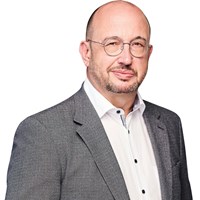Access to energy is the foundation of socioeconomic growth
In an exclusive interview with the Energy Connects Quarterly Review, Dietmar Siersdorfer, Managing Director Middle East and Africa at Siemens Energy, discusses the energy challenges and opportunities in the Middle East and Africa, how Siemens Energy is fostering sustainable development and innovation and supporting the energy transition in the region, and the vital importance of partnerships and collaborations to create a clean-energy future.
Recently you took on the Africa portfolio at Siemens Energy. As the Managing Director of Siemens Energy for Africa and the Middle East, you have a unique perspective on the energy challenges and opportunities in these regions. Let’s start with your primary ambitions for the Middle East. What are your main goals, both in the short term and long term?
In the short term, our primary ambition is to enhance Siemens Energy’s footprint across the Middle East by expanding partnerships with local stakeholders. The challenges across the region vary significantly, from access to energy in the case of Iraq, to decarbonising industry in the UAE and Saudi Arabia, to implementing new technologies like green hydrogen. We aim to tailor our solutions to meet the specific needs of markets, focusing on energy accessibility, reliability, efficiency, and sustainability. Long-term, our goal is to be an integral part of the region’s transition to a more sustainable energy future. This involves supporting the development of renewable energy sources, which will not only help in reducing carbon emissions but also in increasing energy security and supporting local economies. Access to energy is the foundation of socioeconomic growth.
What are the key opportunities within the energy value chain in Africa that Siemens Energy is focusing on?
Although Africa accounts for a fifth of the global population, the region has attracted only 2-3% of global energy investment, according to the ADBG and the International Energy Agency. With a significant shortfall between supply and demand, Africa presents significant opportunities across various segments of the energy value chain, particularly in the generation, transmission, and distribution of electricity. There is a substantial need for stronger, more resilient power generation infrastructure and an interconnected grid network. Renewable energy sources like solar, wind, and hydro are particularly promising due to Africa’s abundant natural resources.
You mentioned the importance of partnerships. Could you explain the synergies and benefits of aligning Siemens Energy’s efforts between the Middle East and Africa?
Last year, companies in the GCC announced 73 foreign direct investment projects in Africa worth more than US $53 billion, according to the World Economic Forum. Much of this investment was directed towards the energy sector. The energy landscape of the Middle East and Africa share several key characteristics, including high renewable energy potential, market dynamics, and developmental goals. Both regions are striving to increase access to energy, accelerate industrial growth, and decarbonise.
By aligning our efforts, we can leverage these similarities to streamline operations and share successful strategies and technologies across regions. For example, solar energy and wind power technologies proven in the arid climates of the Middle East can be adapted for similar environments in Africa. This alignment allows us to optimise resource allocation and expertise, ultimately leading to cost efficiencies and a stronger competitive edge. Additionally, we are seeing a surge in investment between the regions, which further enhances our ability to support energy transition and infrastructure development.
What role does Siemens Energy play in supporting the Middle East’s energy transition, and what strategies are you implementing?
Siemens Energy is committed to being a partner of choice in energising the Middle East. We are focusing on harnessing the region’s abundant natural resources to drive sustainable energy development and economic growth. Our strategies include developing strong and stable grids that can distribute power efficiently, using renewable energy sources such as solar, wind, and modernising aging infrastructure. For instance, in Iraq, we have been awarded long-term service contracts for several power plants, aimed at improving energy stability and availability.
Finally, can you share some specific initiatives or partnerships that Siemens Energy has launched to foster sustainable development and innovation in the Middle East?
One of our key initiatives is the launch of the UAE Innovation Center in partnership with the Abu Dhabi Investment Office. This centre brings together customers, industrial partners, academia, and research centers to accelerate the commercialisation of innovative solutions and drive the energy transition. Additionally, we have been actively involved in several CSR initiatives, such as the Siemens Energy Apprentice Program in Egypt, which provides university students with hands-on experience and training in business improvement techniques.
Last year we also inaugurated our UAE apprenticeship program, helping to develop the skills, knowledge, and career opportunities, of Emirati university graduates. We are also working on establishing a state-of-the-art service centre in Qatar to support the maintenance and repair of rotating equipment across the Middle East and Asia Pacific regions. These initiatives are part of our broader strategy to foster sustainable development, knowledge transfer, and innovation in the Middle East.
Energy Connects includes information by a variety of sources, such as contributing experts, external journalists and comments from attendees of our events, which may contain personal opinion of others. All opinions expressed are solely the views of the author(s) and do not necessarily reflect the opinions of Energy Connects, dmg events, its parent company DMGT or any affiliates of the same.






